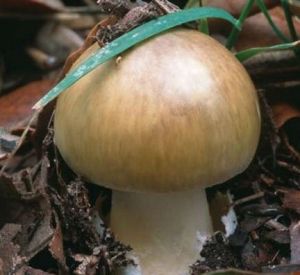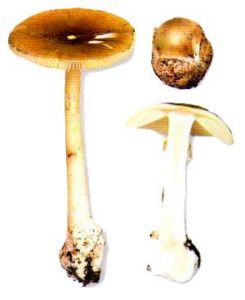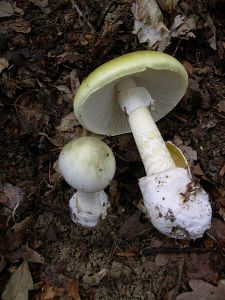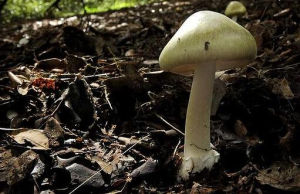Introduction
A kind of poisonous death cap as basidium fungi, on a global scale, this seemingly innocent of fungi but most mushroom - related deaths of culprit A kind of poisonous death cap as basidium fungi, on a global scale, this seemingly innocent of fungi but most mushroom - related deaths of culprit . Don't let the edible mushroom species with the death cap (Amanita phalloides) confusion, which contains the phallotoxin with two amanitin poison, eat only 30 grams of it enough to kill anyone Don't let the edible mushroom species with the death cap (Amanita phalloides) confusion, which contains the phallotoxin with two amanitin poison, eat only 30 grams of it enough to kill anyone .
symptom may be eaten after 8 to 12 hours, but may be within a week caused by renal failure, and death of symptom may be eaten after 8 to 12 hours, but may be within a week caused by renal failure, and death of . 1 1.
Basic Information
umbrella: green or gray, convexly - shaped, the edges are smooth and the surface for the fibrous umbrella: green or gray, convexly - shaped, the edges are smooth and the surface for the fibrous . mushroom pleats: free white stipe mushroom pleats: free white stipe .
: and the same as or a white umbrella, mushroom, 3 - 5 cm wide : and the same as or a white umbrella, mushroom, 3 - 5 cm wide . growth environment: forming mycorrhizal with a variety of hardwood trees such as beech, oak and hazel wood and the like, in the fertile soil on growth environment: forming mycorrhizal with a variety of hardwood trees such as beech, oak and hazel wood and the like, in the fertile soil on .
distribution: it is widely distributed in Europe, they are also found throughout North America distribution: it is widely distributed in Europe, they are also found throughout North America . 13 A. verna) of the cap, the diameter is 5 - 15 cm, with round or hemispherical, but over time slowly become flat 11
cap color with gray, yellowish, olive - green,rain after colors tend to be paler, cap color with gray, yellowish, olive - green,rain after colors tend to be paler, . pileus when wet as a viscous, readily shedding the epidermis 12 pileus when wet as a viscous, readily shedding the epidermis 12 .
verna) of bacteria on the rod body of the ring like a skirt, generally located in the cap and the lower 1 - 1. 5 cm from a white thin .
hangs down freely. It is a white volva, like an airbag swelling 11 due to the volva is its important feature, the cover - up debris should be avoided, in order to check the 11 due to the volva is its important feature, the cover - up debris should be avoided, in order to check the .
Biological Features
Amanita phalloides, is a member of the genus Amanita subjunquillea Amanita phalloides, is a member of the genus Amanita subjunquillea . widely distributed in Europe, and to form mycorrhiza with deciduous trees widely distributed in Europe, and to form mycorrhiza with deciduous trees .
in some cases, the most deadly, Amanita phalloides due to planting such as oak, chestnut and pine trees non - indigenous species, but accidentally spread to new environments, in some cases, the most deadly, Amanita phalloides due to planting such as oak, chestnut and pine trees non - indigenous species, but accidentally spread to new environments, . large parts of plants (fruit body) in the summer and autumn;pileolus cap generally exhibits a green, and white stipe and gills large parts of plants (fruit body) in the summer and autumn;pileolus cap generally exhibits a green, and white stipe and gills .
such a poisonous mushroom can be mistaken for several edible species (especially the likes of Volvariella volvacea) eaten by humans, thus leading to accidental poisoning of a rise in the proportion 2 such a poisonous mushroom can be mistaken for several edible species (especially the likes of Volvariella volvacea) eaten by humans, thus leading to accidental poisoning of a rise in the proportion 2 . verna is a known poisonous mushrooms in the most cruel of all mushrooms verna is a known poisonous mushrooms in the most cruel of all mushrooms .
this mushroom in humans due to toxic mushroom poisoning deaths, more than half, and possibly the Roman emperor Claudius and Holy Roman Emperor Charles VI's death to this mushroom in humans due to toxic mushroom poisoning deaths, more than half, and possibly the Roman emperor Claudius and Holy Roman Emperor Charles VI's death to . verna) became the subject of considerable research, and its biologically active substances are also separated verna) became the subject of considerable research, and its biologically active substances are also separated .
main toxic substance is alpha - amanitin,Usually the main part of the liver and the kidney cause a lethal damage to main toxic substance is alpha - amanitin,Usually the main part of the liver and the kidney cause a lethal damage to . there is no known antidote found decisive there is no known antidote found decisive .
Chemical Nomenclature
Amanita phalloides is first described, in 1727, French botanist Sebastian Van Lien Te by Amanita phalloides is first described, in 1727, French botanist Sebastian Van Lien Te by . he was given a name and a concise description: "phalloides, annulatus, virescens, et", this was considered to be fungi, that is still to be recognized is thus 3 he was given a name and a concise description: "phalloides, annulatus, virescens, et", this was considered to be fungi, that is still to be recognized is thus 3 .
though its formal name "phalloides" meaning" penis", it was not clear whether this is because the naming of literally resembling a penis,Or on the classification and dictyophora phalloidea, likewise with the Phallus though its formal name "phalloides" meaning" penis", it was not clear whether this is because the naming of literally resembling a penis,Or on the classification and dictyophora phalloidea, likewise with the Phallus . in 1821, Yi - Les Magnitogorsk, Fries described it and named Agaricus phalloides, but this range named all the white species of fungi in 1821, Yi - Les Magnitogorsk, Fries described it and named Agaricus phalloides, but this range named all the white species of fungi .
4 4 . Finally in 1833, Johann Heinrich Friedrich Link decision named phalloides 5, 30 years after Christian Hendrik culture life called Amanita viridis,But late - 6 Finally in 1833, Johann Heinrich Friedrich Link decision named phalloides 5, 30 years after Christian Hendrik culture life called Amanita viridis,But late - 6 .
7 though Louis Sachar in early Burin g also use phalloides, this nomenclature controversy Isaac Dayton was dismissed as of the end, because his firm did not use binomial nomenclature 7 8, however some taxonomists have different opinions on this result of the 9 7 though Louis Sachar in early Burin g also use phalloides, this nomenclature controversy Isaac Dayton was dismissed as of the end, because his firm did not use binomial nomenclature 7 8, however some taxonomists have different opinions on this result of the 9 . 10 10.
Taxonomy
verna is a species of Amanita species mode section, this section contains all of the early identification of toxicity of the Genus Amanita species verna is a species of Amanita species mode section, this section contains all of the early identification of toxicity of the Genus Amanita species . in the most famous of these species is referred to as" destroying angels" Amanita virosa, the Angel of Death and the White Umbrella in the most famous of these species is referred to as" destroying angels" Amanita virosa, the Angel of Death and the White Umbrella .
"destroying angel" (angel), this name is sometimes also applied to the most deadly, Amanita phalloides, but "death cap mushroom" (death cap), have become among the most common vernacular name "destroying angel" (angel), this name is sometimes also applied to the most deadly, Amanita phalloides, but "death cap mushroom" (death cap), have become among the most common vernacular name . other common names include "stinking amanita mushroom" (roaring) and "Amanita exitialis"( other common names include "stinking amanita mushroom" (roaring) and "Amanita exitialis"(.
) A rare White fruit, which was started by Max's Bi is considered to be one of the most deadly, Amanita phalloides, and named as A. phalloides" f. alba, although it's not clear this long strain is found in ordinary color of Amanita phalloides strain is found in ordinary color of Amanita phalloides .
growth in 2004, it has been described as one of the different varieties, and is identified as amanita phalloides variant of "A. verna var. tarda true White Umbrella plant parts in the spring because of the action of potassium hydroxide and the yellowing, but not the most deadly, Amanita phalloides true White Umbrella plant parts in the spring because of the action of potassium hydroxide and the yellowing, but not the most deadly, Amanita phalloides .
Toxicity
As the name implies, death cap mushroom can be poisonous, that is the world's most poisonous mushrooms As the name implies, death cap mushroom can be poisonous, that is the world's most poisonous mushrooms . according to estimation, eating about 30 grams or half a cap can be a lethal according to estimation, eating about 30 grams or half a cap can be a lethal .
15 2006, one of three Polish families after a death, the two survivors requiring liver transplant 15 2006, one of three Polish families after a death, the two survivors requiring liver transplant . 16 at the end of 2011, in Canberra, Australia have four Asians due to accidental ingestion may lead to death or liver transplantation have 16 at the end of 2011, in Canberra, Australia have four Asians due to accidental ingestion may lead to death or liver transplantation have .
authorities recommend avoiding contact Amanita phalloides authorities recommend avoiding contact Amanita phalloides . 12 17 In addition, the most deadly, Amanita phalloides toxicity cannot pass through the boiled, frozen or dried in a method of minimizing the 12 17 In addition, the most deadly, Amanita phalloides toxicity cannot pass through the boiled, frozen or dried in a method of minimizing the .
In the past decade or so,Scientists have made in - depth study on its toxicity In the past decade or so,Scientists have made in - depth study on its toxicity . 18 18.

